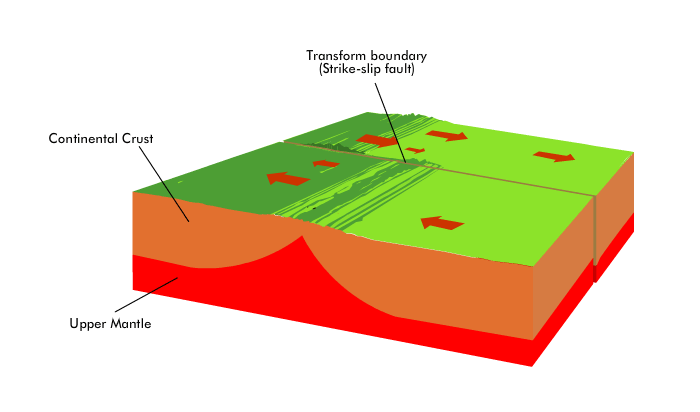Slip, Slide, & Collide
Divergent Boundaries — Spreading Plates
At divergent boundaries, tectonic plates are moving away from each other. But if these huge masses of crust are moving apart, what happens in the space left between them?
Seafloor Spreading
Divergent boundaries in the middle of the ocean contribute to seafloor spreading. As plates made of oceanic crust pull apart, a crack in the ocean floor appears. Magma then oozes up from the mantle to fill in the space between the plates, forming a raised ridge called a mid-ocean ridge. The magma also spreads outward, forming new ocean floor and new oceanic crust.
Rifts
When two continental plates diverge, a valleylike rift develops. This rift is a dropped zone where the plates are pulling apart. As the crust widens and thins, valleys form in and around the area, as do volcanoes, which may become increasingly active. Early in the rift formation, streams and rivers flow into the low valleys and long, narrow lakes can be created. Eventually, the widening crust along the boundary may become thin enough that a piece of the continent breaks off, forming a new tectonic plate. At this point, water from the ocean will rush in, forming a new sea or ocean basin in the rift zone.
Transform Boundaries — Grinding Plates
At transform boundaries, tectonic plates are not moving directly toward or directly away from each other. Instead, two tectonic plates grind past each other in a horizontal direction. This kind of boundary results in a fault — a crack or fracture in the earth's crust that is associated with this movement.
Faults and Earthquakes
Transform boundaries and the resulting faults produce many earthquakes because edges of tectonic plates are jagged rather than smooth. As the plates grind past each other, the jagged edges strike each other, catch, and stick, "locking" the plates in place for a time. Because the plates are locked together without moving, a lot of stress builds up at the fault line. This stress is released in quick bursts when the plates suddenly slip into new positions. The sudden movement is what we feel as the shaking and trembling of an earthquake.

The motion of the plates at a transform boundary has given this type of fault another name — a strike-slip fault. The best-studied strike-slip fault is the San Andreas Fault in California. It is located at the boundary between the Pacific and North American plates and runs roughly 800 miles (1,300 km) through Northern and Southern California. As the two plates grind past each other — the Pacific Plate moving northwest and the North American Plate moving southeast — the motion produces numerous earthquakes along the fault. While many are small and cause only minor trembling, the San Andreas Fault has also been the site of major events: the 1857 Fort Tejon earthquake, the 1906 San Francisco earthquake and fire, and the 1989 Loma Prieta earthquake. Many scientists believe that the San Andreas Fault is due to unleash another large earthquake — a "big one" — in the coming decades.
| Plate Interactions Challenge See if you can figure out the plate movements and geologic events occurring at real-world locations. |